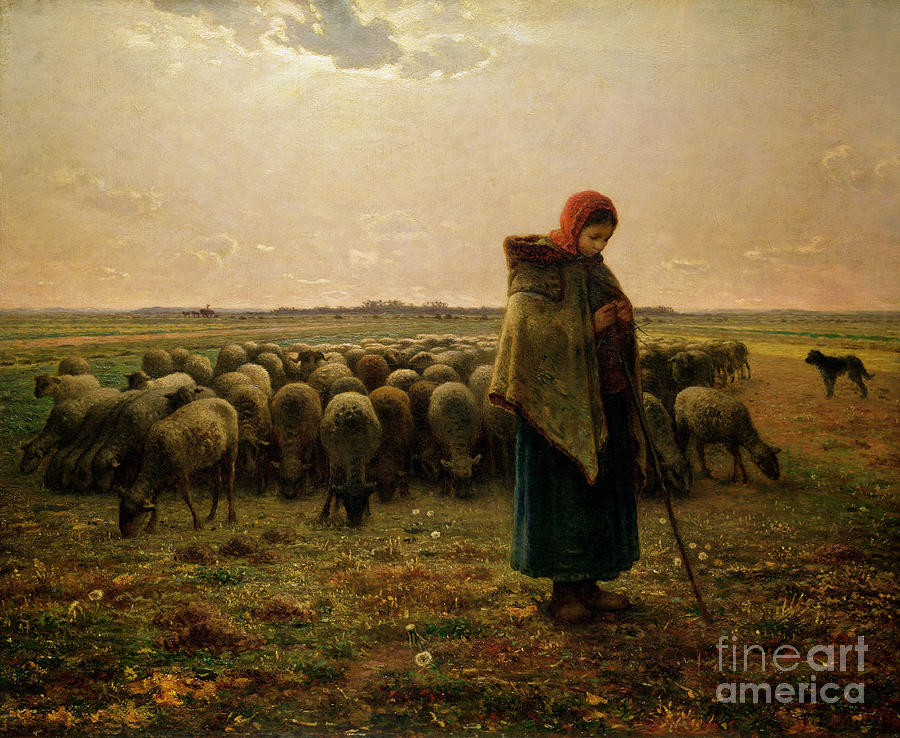
Shopping for a Shepherd: A Female Shepherd Like Rachel
I noticed the aroma of spiced apples scenting the air as I stepped into the shop. My eyes lighted on the carved wooden figures grouped into Nativity sets and nestled on long shelves lining the walls. Our group of fourteen had spent the morning touring biblical sites in Jerusalem, followed by lunch and a visit to the Church of the Holy Nativity in Bethlehem, part of the Palestinian-administered area of Israel. To finish the day, we were driven nearby for a requisite gift shop stop.
Sipping complimentary apple cider, my husband Lindsey and I began browsing the wares. We had purchased an olive wood nativity set during our first trip to Israel several years prior. On this visit, we hoped to add a new shepherd or two.
Shopping for a Shepherd
A salesman approached asking to assist us.
“Yes,” I said, “We’re looking for a carved figure of a female shepherd.”
His eyes widened as he stammered, “A female shepherd?”
Shaking his head, he called to another salesman nearby and asked him, “Do we have any female shepherd figures?”
The second salesman chuckled and said emphatically, “What? Females aren’t shepherds!”
Lindsey remarked, “What about Rachel, Jacob’s wife? She’s named as a shepherd in the Bible.”
Recognition immediately lit up both the salesmen’s faces.
Rachel, A Shepherd
Truth can prompt a paradigm shift. Lindsey, in his recent devotional reading in the book of Genesis, was surprised to learn of Rachel’s profession as a shepherd. The biblical account states, “Rachel came with her father’s sheep, for she was a shepherd” (Gen 29:9).
Rachel, the daughter of Laban, met her future husband Jacob at a well where she brought her father’s flocks to be watered. She was accepted as a respected colleague in the sheep-herding business and became a matriarch of Israel. Rachel had two sons, Joseph and Benjamin. Saul, Israel’s first king, came from the tribe of Benjamin. And, two of Israel’s twelve tribes were named after Joseph’s sons, Manasseh and Ephraim.
Adjusting Assumptions
One’s cultural norms often shape our assumptions. Once upon a time, I assumed that out-of-doors jobs like roof building and shepherding—herding flock(s) of animals, walking miles in all kinds of weather, living “rough” at times while tending to neglected, sick, and lost lambs, and defending them against predators—are male-only jobs. However, in rural South Africa, some women work as roofers, and many women gather, dry, bind, and construct the thatched roofs of their homes.
In the Ancient Near East, girls often participated in the “family business” of shepherding. One of the oldest professions, shepherding is essential to the livelihood of pastoral people groups. Today, among the Turkana and the Maasai in East Africa boys and girls around the ages of 6–7 begin herding young animals. Older children are responsible for the larger livestock. Maasai women shepherds care for small livestock and cattle.[1]
Zipporah, A Shepherd
In addition to Rachel, the Old Testament describes other women shepherds: Zipporah, her six sisters, and the Shulamite woman. Jethro, the priest of Midian, had seven daughters. His daughters shepherded his flocks. Zipporah, one of Jethro’s daughters, later married Moses. Like Rachel’s story, Zipporah met her future husband at a well while watering flocks entrusted into her care (Ex 2:16–21).
The Shulamite Woman, A Shepherd
In the Song of Songs, the Shulamite woman describes herself as “dark like the tents of Quedar.” Her lover calls her, “O most beautiful of women” and tells her, “Pasture your little lambs beside the tents of the shepherds” (Song of Solomon 1:5-8). The Hebrew word for “pasture,” as in “one who pastures a flock,” is rā ‘â, a word also translated as “shepherd.” The word rā ‘â describes the Shulamite woman, Abel, Rachel, Laban, Jacob, Joseph, Moses, and others.
Current Day Female Shepherds
A 2018 documentary titled In Questo Mondo (In This World) tells the stories of current-day female shepherds who work in Italy’s pastoral regions. Anna Kauber, the film’s director, spent two years interviewing over 100 female shepherds ranging in age from 20 to 102 years. Her film highlights the stories of twenty-two of these female shepherds, emphasizing their impact on their small communities, and the various struggles they overcome as shepherds of family and flocks.[2]
Shepherd as a Metaphor
Shepherd is used throughout the scriptures as a metaphor for a caretaker of a flock. A metaphor that applies to females and males. And, a flock represents God’s people. God is described as the shepherd of Israel tending to his flock, “He gathers up the lambs with his arm; he carries them close to his heart; he leads the ewes along” (Isaiah 40:11; Ps 23). God’s Son, Jesus, introduces himself as the “Good Shepherd” who “lays down his life for the sheep” (John 10:11).
Jesus is the model example for shepherding. His shepherds willingly and humbly serve in whatever capacity needed, exemplifying faithfulness and a godly character. A good shepherd cultivates good listening skills and serves with tender loving care, empathy, and compassion while standing resolute and unswerving against any and all who cause harm or havoc.
Female Shepherds in the New Testament
New Testament women shepherded people. Top of mind are the many female house church hosts who held significant shepherding responsibilities. These women include Lydia (Acts 16:40), Priscilla (1 Cor 16:19; Rom 16:3–5), Chloe (1 Cor 1:11), Apphia (Philemon 1:1–2), Nympha (Col 4:15), the Chosen Lady (1 John 2), and Mary, the mother of John (Acts 12:12). Another shepherd of people was Mary, Jesus’s mother. She traveled with Jesus and participated in his ministry. Mary was present when the Holy Spirit descended at Pentecost, and she witnessed Jesus’s death, burial, and resurrection.
Tabitha: A Shepherd to Widows
Tabitha is another New Testament woman who shepherded a flock. Also known by her Greek name Dorcas, Tabitha has the unique distinction of being the only person in the Bible named a disciple—she is called a “mathētria,” which is the feminine form in Greek for “disciple.” Her story begins, “Now in Joppa there was a disciple [mathētria] named Tabitha… She was continually doing good deeds and acts of charity.” Peter miraculously raised her from the dead, and then “he called the saints and widows and presented her alive…and many believed in the Lord” (Acts 9:36–43). Tabitha shepherded widows, one of the most vulnerable flocks in her day.
Conclusion
I’m still shopping for a female shepherd to add to our nativity set. Yet, neither you nor I need a physical token to remember and emulate the exemplary women shepherds found throughout the ages. Women who served those entrusted to their care with Jesus-like shepherding—not lording over, but serving with character, strength of resolve, compassion, and sacrifice. Will you join me in recounting the stories of female shepherds to your daughters, sons, grandchildren, and those entrusted to your care?
Photo: Jean-Francois Millet (1814–75), Shepherdess with her Flock (oil on canvas), 1863.
[1] Funlola, Olojede, “Rachel: The Shepherdess among Shepherds,” (2015), 11. https://www.researchgate.net/publication/272357007_Rachel_The_Shepherdess_among_Shepherds
[2] “In This World…Let’s Give Voice to Women Pastors,” Solares Fondzione delle Arti. https://www.ideaginger.it/progetti/in-questo-mondo-diamo-voce-alle-donne-pastore.html?fbclid=IwAR1Ii3A7v3Vk8Pz2mK1qaaH0UgSJFOi2fF6W03-LBZZxU_Bqzsu0o-W_H5k




